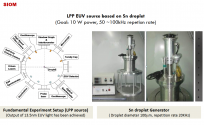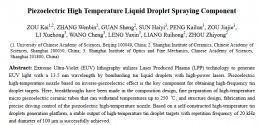broadsword
Brigadier
Wouldn't the SSMB probably be much further down the road than EUVL?
SSMB is just a very high power [kilowatt range] and very clean light source for an EUVL system, they already working on it.Wouldn't the SSMB probably be much further down the road than EUVL?
If they were limited at 20 kHz before it might not be (in my estimation probably isn’t) because they were technically limited by the ability to generate a higher frequency of drops, but were instead limited in other parts of the system that could not operate at a higher frequency of actions. For example the drive laser pulses need to match the frequency of the droplets, and while usually pulsing lasers at high frequency is easy to do perhaps they couldn’t do this at the requisite pulse power output they needed. Alternatively, based on the paper’s own contents, it might be a noteworthy accomplishment more from the standpoint of runtime or being able to maintain favorable stream and droplet characteristics since there’s a difference between breaking your stream into the right drop frequency and doing it in a way that makes the drops usable.Considering that last time I remember their rate generation was just 20Khz, means the have achieve some progress in molten droplet generation, but the paper said there is still some work. If you ask me I am thinking they are going for a lot of EUV power.
For the laser configuration this paper stated a preference for a C02 MOPA laser.
Personally as exciting as would be seeing China developing their own High power EUV LPP light source I am putting my money in Free Electron Lasers-like sources like SSMB and others as the future of EUV lithography.
The commercialization of EUV lithography in China is advancing.
View attachment 122209
View attachment 122207
View attachment 122208
This is about the EUV wavelength photosensitive chemical that will be used as a film to pattern the circuits components into the wafer.Could you explain more about these ?
Is this about the EUV like ASML or the new SSMB ?
Yes I think that is for their 250W light source, their High NA system will double that to 500W so will be a pick your poison between the power and RR of the MOPA laser, the size of the collector mirror and frequency of the droplet generator. Multilayered mirrors are at the limit of their efficiency so better mirrors seems to be not an option.If they were limited at 20 kHz before it might not be (in my estimation probably isn’t) because they were technically limited by the ability to generate a higher frequency of drops, but were instead limited in other parts of the system that could not operate at a higher frequency of actions. For example the drive laser pulses need to match the frequency of the droplets, and while usually pulsing lasers at high frequency is easy to do perhaps they couldn’t do this at the requisite pulse power output they needed. Alternatively, based on the paper’s own contents, it might be a noteworthy accomplishment more from the standpoint of runtime or being able to maintain favorable stream and droplet characteristics since there’s a difference between breaking your stream into the right drop frequency and doing it in a way that makes the drops usable.
For reference, ASML’s EUV instrument has a drop frequency of 40-50 kHz if I recall correctly.
As convoluted as may seem now everyone seems to be looking to FELs to solve the EUV power and efficiency problem.But yes, while the physics behind LPP is pretty fun and interesting I too am looking forward more to SSMB. Convoluted engineering is great from a novelty standpoint but a headache to think about once you get into practical applications.


I'm guessing the 250W system is for moving current 7nm and near future 5nm production from DUV to EUV while the 500W High NA system is for 3nm onwards?Yes I think that is for their 250W light source, their High NA system will double that to 500W so will be a pick your poison between the power and RR of the MOPA laser, the size of the collector mirror and frequency of the droplet generator. Multilayered mirrors are at the limit of their efficiency so better mirrors seems to be not an option.
As convoluted as may seem now everyone seems to be looking to FELs to solve the EUV power and efficiency problem.
The 500W is for throughput and the High-NA [0.50] is for the Critical Dimension, reduce the need for multi-patterning although there still some issues that have to be dealt with.I'm guessing the 250W system is for moving current 7nm and near future 5nm production from DUV to EUV while the 500W High NA system is for 3nm onwards?
